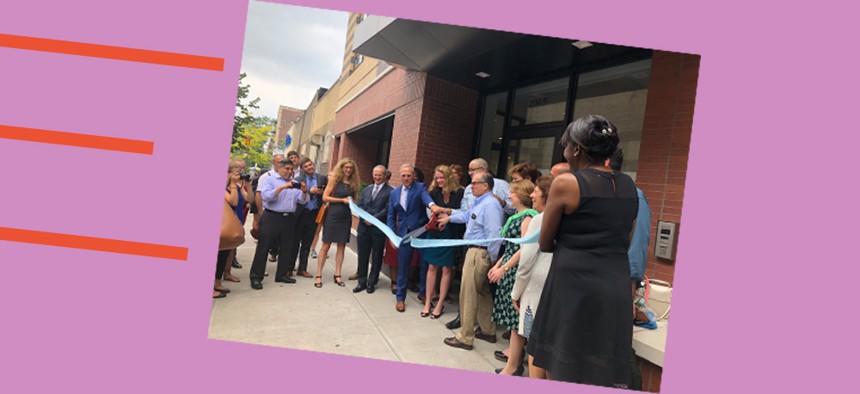Nonprofit housing development brings together New York City veterans and LGBTQ youth
Walton House is the first development to open under the city's 15/15 housing initiative.

Ribbon cutting at Jericho Project's Walton House development David Gentile
Jericho Project has opened New York City’s first development under Mayor Bill de Blasio's 15/15 supportive housing initiative and it serves an intergenerational population of homeless veterans and young adults – the Walton House development in the University Heights area of the Bronx.
Creating supportive housing for New York City’s homeless veteran population is not a new undertaking for the Jericho Project, which operates or manages more than 500 supportive housing units throughout the city. But housing them alongside young adults – 40 percent of whom identify as LGBTQ – is a first.
The nonprofit delved into intergenerational supportive housing after observing an increased need for housing to assist the homeless young adult community.
“We saw that, just like with the veterans a decade ago, homelessness among the young adult population was at a crisis (level),” Jericho Project CEO Tori Lyon said in an interview with New York Nonprofit Media. “We thought we could bring the two populations together.”
The 15/15 initiative, introduced in 2015, calls for the creation of 15,000 supportive housing units over the next 15 years as part of de Blasio’s plan to respond to record homelessness. The populations served by the initiative include homeless families, homeless single adults, young adults, and homeless veterans. It will cost the city approximately $1 billion over the full 15 years. The plan calls for 7,500 units to be constructed at a cost of $2.6 billion in capital funds and 7,500 scatter site units to be converted into supportive housing.
Approximately $1 billion of the $2.6 billion will be funded by the city. Part of the remaining costs will be offset by low-income tax credits and private sources. Urban Pathways, Breaking Ground and Odyssey House are among about a dozen nonprofits working with the city on this initiative.
The $35.6 million Walton House development is the first to open under a plan that the city called "unprecendented" for its commitment to generate more units per year than any of its previous initiatives.
The City Council has been critical of the rate of progress under this initative. As of April of this year – about four years into the project – only 337 formerly homeless New Yorkers had reportedly moved into a supportive housing unit. The $35.6 million, 10-story Walton House project took a total of four years to come together. but Lyon said that is a fairly typical timeframe for a project of this size. The only significant time-consuming snag was when a contractor dropped out, delaying them for a few months, according to Lyon.
That is not to say the process was easy. It took a collaborative effort from city agencies, and public and private partnerships to be able to complete the project. “It takes a village to build a community,” Herminia Palacio, deputy mayor of health and human services, said at the ribbon cutting. “This is not just a building. It’s a community.”
Jericho Project’s main work has been with veterans, so the organization needed to learn about the young adult population they will serve, according to Lyon. So the nonprofit reached out to other housing providers and young adults in order to learn more about the specific needs of the population. As a result, Jericho Project was able to modify their services in a way they think will speak to young adults.
“For example, normally we would use the term 'case manager,' but we’re using ‘life coach’ instead,” said Lyon. “We want to really try to relate to the young adults.”
The development will house veterans and young adults on different floors among 89 units, with each population having its own community space. There will be 56 for veterans and 33 will for young adults. All of the apartments will be affordable to individuals who earn an annual income of $18,150 or less. Their rent will be limited to 30 percent of their income.
Lyon hopes real bonds can be formed. “We also see this as, people of different generations, from different backgrounds, can come together and form a community,” said Lyon. “We’re very excited about that.”
In line with the supportive housing model, each resident will have access to career counseling, job placement, family reunification, educational assistance and mental health services. In addition, every person that lives there was told from the first day that it was an LGBTQ-affirming community which will be open and welcoming, Lyon said.
Others in the field of supportive housing say both populations have something to gain here. "Needs can be met on both sides. You will have mentorship from the veterans to the young adults,” said Robert Yancey, chief program officer for the Neighborhood Coalition for Shelter. “And the young adults will get to fulfill their need to care for someone.”
Yancey, like Lyon, thinks the two groups will be able to bond. “For the most part when people live together in a community, the gap of understanding tends to work itself out.”
Lyon is also optimistic that the city can achieve its goals on time. “The will is there, by the mayor, and by the city agencies. The funding is there,” said Lyon. It’s only 1,000 units a year. If you break it down that way, it doesn’t seem so impossible.”
